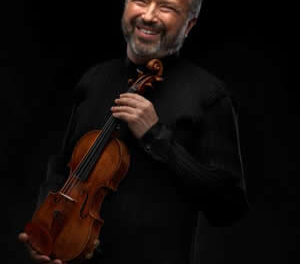For the seventh consecutive year, the spirit of cooperation and coordination among the “Big Three” chamber music presenters in the Triangle resulted in a September Prelude concert series that was an artistic triumph. This year featured Brooklyn Rider, a young, adventurous, genre-defying string quartet that boldly goes where most string quartets dare not travel, yet also upholds the rich heritage of the traditional quartet repertoire. The middle leg of this three-concert series was presented by Duke Performances at Reynolds Theater and also served as the kickoff of the 2010-11 Chamber Arts Society of Durham season.
Brooklyn Rider’s lineup is the brothers Colin and Eric Jacobsen, violin/composer and cello respectively, Johnny Gandelsman, violin and Nicholas Cords, viola. Their performance style is almost identical to the Emerson string quartet as the three chin-holding instrumentalists play standing up while the cellist is perched on a platform. Also like Emerson, the two violinists alternate first and second parts. These fabulous young musicians have an endearing and genuine stage presence and are obviously aware that a large percentage of the audience is attending because of the “anchor” piece (violist Cords’ description of the standard repertoire work in each program). Their programming is a nearly perfect amalgam of the new, nearly new and old armchair favorites.
The first piece on the program, Achilles’ Heel,slowly unveils the talents of each player as well as the composing skills of violinist Jacobsen. The brothers Jacobsen begin this work with an extended modal filled violin/cello duo. The work is written in homage to Debussy and with the eventual joining of the viola and second violin we get the full treatment of the “pleasure is the law” principle of music making. With this performance we get the total package of seemingly effortless virtuosity, emotive communication and joyous playing. If there were any doubts about these relative newcomers from my own Brooklyn hometown, they were quickly dispensed.
Although traditionalists may scoff at the thought of chamber musicians as “entertainers,” it is remarkable what a few well-placed and engaging remarks to the audience will do for the ambience of a concert. Violist Cords and cellist Jacobsen made the audience feel at ease and wowed many with their admission that they had been invited to play at center court of the U.S. Open on this night. They even acknowledged and assuaged fears that the next piece, String Quartet No. 2 by Philip Glass, would loop forever by saying that it was the “shortest and most compact” of his string quartets. Brooklyn Rider should know since they have recently completed recording the complete string quartets of Glass. This one was indeed a textbook example of the composer’s unmistakable style, and perfect in its arc and brevity. The quartet displayed a commanding sensitivity to dynamics as they imbued the repeating small musical cells with remarkable diversity. Although not always the case, for this quartet Glass knew when to say when.
The first half closed with, as cellist Jacobsen described, an “athletic” work by Giovanni Sollima: “Federico II” from Viaggio in Italia. This is the work of the evening that showcases their categorization as a rock band string quartet, and perhaps is used to lure unsuspecting audiences into listening to “standard” chamber music. This work is a fascinating mixture of Middle Eastern modes combining with Celtic fiddling into a type of Italian bluegrass. Just the first part of an hour-long musical journey through the cultural history of Italy, “Federico II,” written in 2000, is an unabashed celebration of rhythm and a shameless display of virtuosity – it was fantastic!
After intermission we come to the very weighty “anchor,” Schubert’s “Death and the Maiden” string quartet. This is where it seems that their adrenaline may have got the upper hand of their musical judgment. The opening movement, one of the most tense, passionate and foreboding in all of music, sounded rushed and out of control, despite the fact that their prodigious technique was more than capable. The second movement, a brilliant theme and variations on an absurdly simple theme, was much more balanced and musically satisfying. Speed and fireworks were more appropriate to the final two movements than the opener and Brooklyn Rider demanded and received your rapt attention to every note and phrase.
The paradox of Brooklyn Rider is that for such an urban, modern, hip ensemble they almost resemble a HIP group: limited use of vibrato, generally faster than usual tempi, and the unusual feature of violinist Gandelsman holding his bow way above the frog (lower end of the bow) in the manner that many Baroque string players would do.
They ended with a wonderfully quirky piece called “The Finnish Tango” – think about that possibility! Once you’ve got great musical knowledge, unfailing rhythmic accuracy and tons of technique (see, that’s all), the mantra of great music making is energy, energy, energy – both internal and external. Brooklyn Rider has all of that, and more. Brooklyn rocks!











